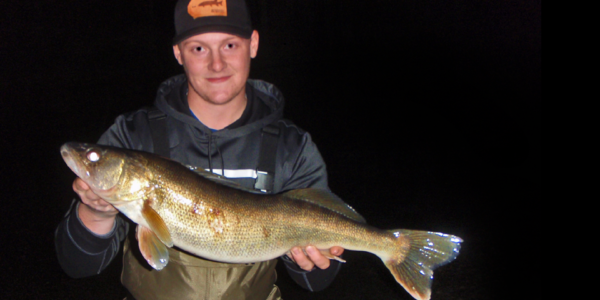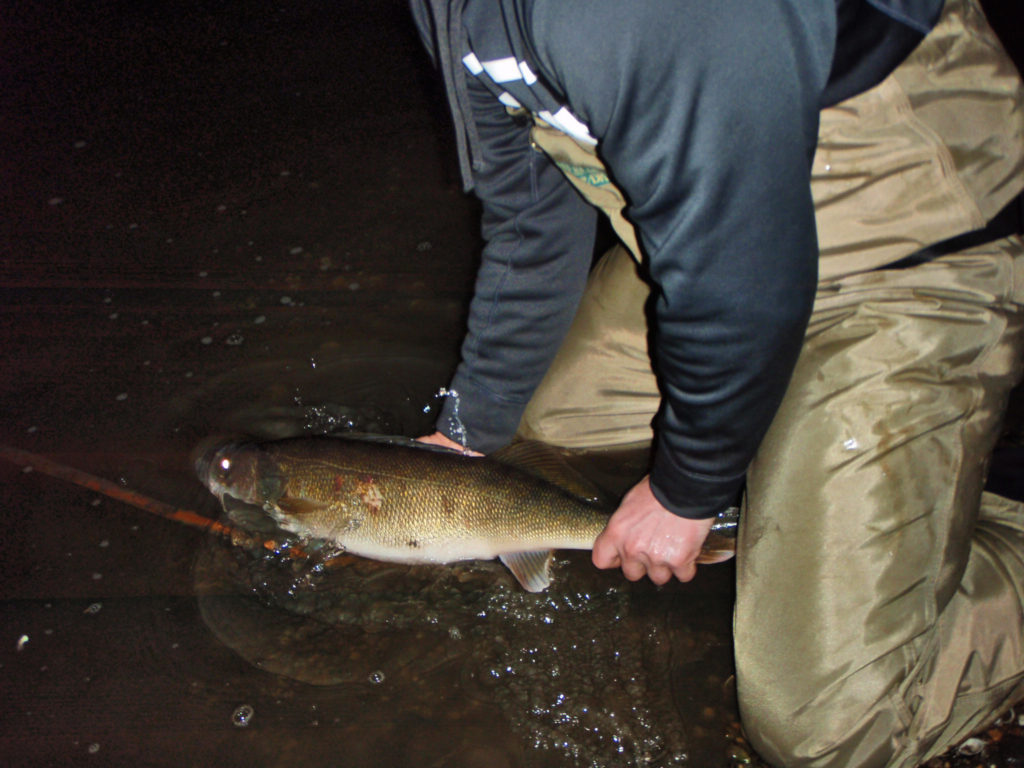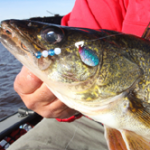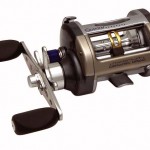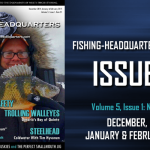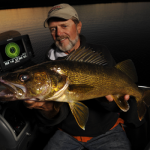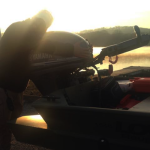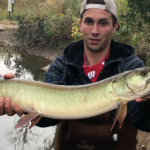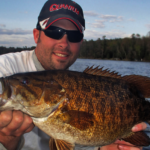By Andrew Ragas
Rivers and streams offer early season open water fishing opportunities as migrating walleyes surge upstream on their annual spawning runs.
Survival of the fittest is defined as the continued existence of living organisms that are best adapted to their environment. Made famous by Charles Dawin’s evolutionary theory, the biological concept of fitness is defined as reproductive success; a creature’s survival that will leave the most copies of itself in successive generations. As a young student I learned a lot about Darwinism in my science courses. In my adult fishing life, I’ve learned a lot more in how survival of the fittest applies to fish species and fisheries.
Let’s take walleyes for example. Throughout their existence, walleyes evolved into migratory river species. When their habitats are suitable, they are prolific reproducers in rivers. In most river systems that support good adult walleye populations, they are often one of the top predators of the food chain and exemplify the Darwinian Theory.
Each spring, mature walleyes undergo the biologic urge to undertake extensive upstream migrations to reproduce, and fulfill their life’s obligations. The spring spawning migrations take place on rivers and creeks of all sizes. The most extensive migrations occur on the major rivers of the Upper Midwest, and Great Lakes tributaries and feeder streams.
Where I fish each spring in Northern Illinois, walleyes migrate throughout a network of inter-connected rivers and smaller tributaries to fulfill their reproductive obligations. While my local river fisheries aren’t blessed to have abundant populations and reproductive success like neighboring world class river fisheries in Ohio, Michigan, Wisconsin and Minnesota, stocking has helped maintain the low density walleye fisheries we have in Illinois. These successful efforts have given wading river anglers like me an opportunity to reap the rewards of some of the best and most intriguing type of walleye fishing there is, done by wading in rivers.
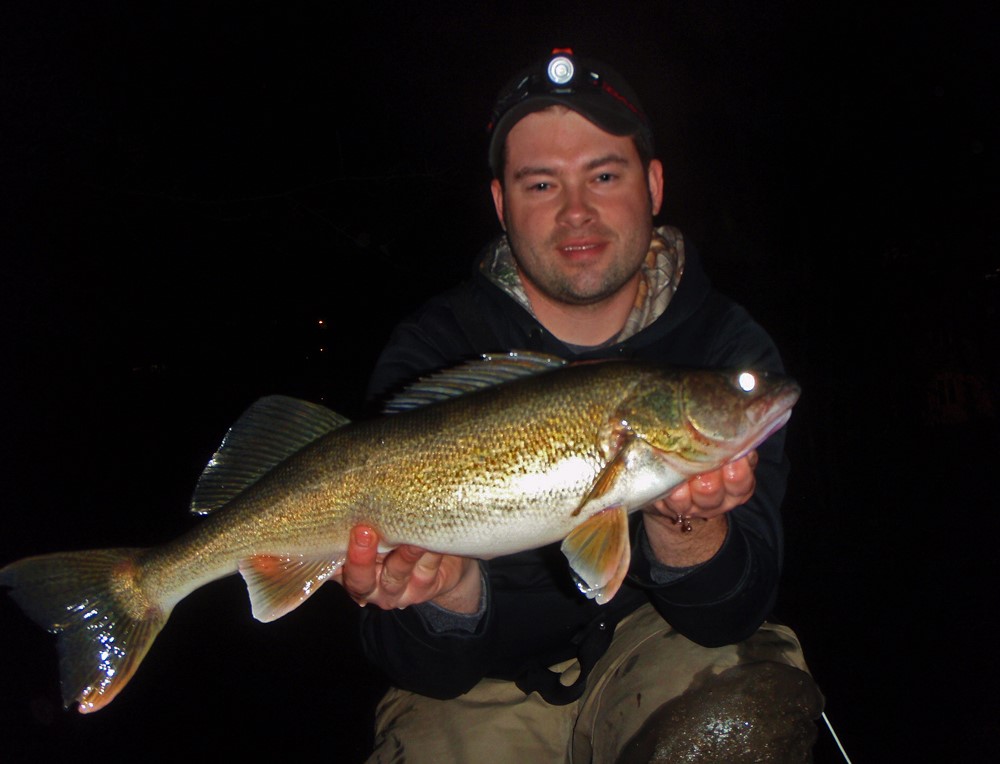
Motivated to Migrate
Typically, spawning is weather and water-temperature dependent, and will occur in the N. Illinois region from early March through mid April.
During the pre-spawn, spawn, and post-spawn periods, walleyes are programmed to complete majority their activities at night. From migrating, to feeding and homing, and spawning, walleyes are restless at night. They have the nighttime advantage over other species due to eyesight adaptations, feeding behavior and success, and strategy to lay eggs over rocky shoals and shallow riffles in incognito, under the mysterious cover of darkness.
In barrier-free systems, walleyes are known to migrate for several miles for feeding and refuge until they locate an ideal range for homing. However for spawning, most migrations are known to be less than 10 miles in length. Spring spawning migrations are most likely made to the nearest spawning sites, though migrations of great distances do occur. Studies presented by N. Illinois stream biologists indicate adult walleyes return annually to the same spawning grounds each spring, an activity known as a repetitive migration.
Due to the migratory nature of walleyes, adult fish have the ability to home in to specific spawning sites. This is an acquired adult behavior influenced by the river’s size, shape, structure, and locations of suitable spawning areas. By roaming and traversing between pools, walleyes eventually become familiar with the layout and best spawning areas of a river. Migrating in schools helps explain how walleyes find spawning sites, and then return to them with greater efficiency each year of their lives.
Warming weather and water temperatures, in conjunction with darkness, are primary spring migration triggering factors. However, river and stream discharge-related events are important stimuli for walleye spawning migrations too. Evidence shows that many adult fish are stimulated to migrate upstream on spawning migrations during, and following, periods of high stream flow. Warming climate, the spring thaw and snow melt, as well as the rain season results in an increase of river discharge and helps trigger upstream walleye movements.
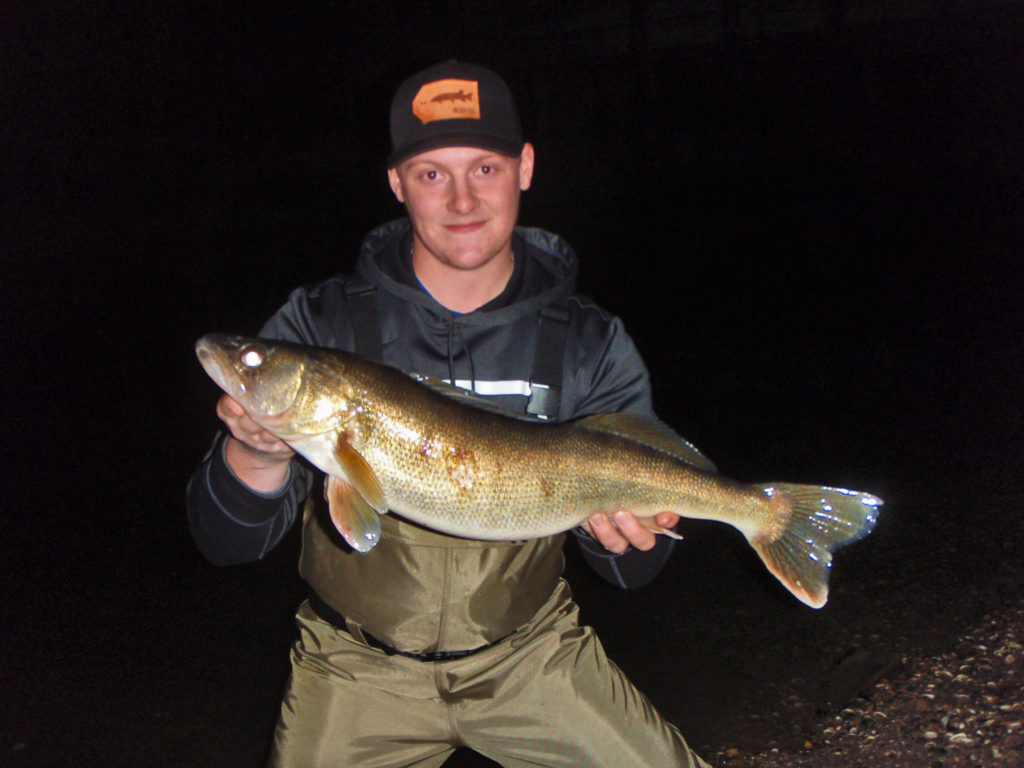
Spring Spawning and Fishing Locations
Pinpointing spring walleye locations correlates mostly to progression of the river migration and spawning locations. Walleyes on their spawning run require cover and resting areas. Current is both their friend and foe. While currents guide them upstream, they’ll take structural paths providing them the least resistance and most resting points. Laydowns, rock piles, shoreline eddies and current breaks, and bridge abutments provide them with ideal cover while en route upstream. Throughout the day walleyes will hold around these locations, but they are more inclined to be actively spawning and feed during the nighttime hours.
After ice out, the smaller males are the first to undertake the spring migration. They will locate their spawning grounds in shallow water, and hold on them for up to a month for feeding and spawning with females. On spawning grounds males far outnumber the females. Large females move in and out of spawning areas quickly, much faster than most anglers think. They quickly vacate spawning areas in search of a nearby deep water refuge to use for recuperation and feeding if an immediate source of forage is present. Large females are very difficult to catch while spawning, and reluctant to bite for up to a two-week period following the rigors of procreation. Therefore pre-spawn is the most ideal time for targeting actively feeding fish, as females are building up their energy reserves and metabolism is high.
The best walleye spawning habitats are large sloping shallow gravel bars comprised of pea gravel and palm sized rock, with moderate to slower gradient current rich in dissolved oxygen passing over and through them. Walleyes disperse their eggs and milt over the shallow current-oxygenated structures.
The free flowing rivers of northern Illinois that I encounter spawning walleyes at have a fairly low to medium gradient of flow, with an average discharge rate (under normal water levels) of 80 to 500 cubic feet per second. In these streams, long deeper pools are often linked together with sections of shallow riffles and current runs that feature a moderate current and depth. A lot of structural obstacles are located in between, which are early season fish magnets that migrating fish will use as rest stops. These rivers are best fished when current flow is stable and water levels stay consistent, but in spring, higher water levels are beneficial in activating walleyes and increasing their aggression as long as water clarity isn’t turbid or poor in visibility.
Under spring conditions and water levels, walleyes are on the move and feeding, and not homing in any specific hole or place unless nearby a spawning site. Being a mobile angler in waders will allow you to catch fish in spots where their spring spawning migration route offers them ideal feeding opportunities. Channel edges, current breaks, deep holes formed by their spawning gravel bars, and slackwater pools are used as their resting areas and ambush points. Keeping these areas in mind, walleyes will undoubtedly be more concentrated in and around the areas where they are known to spawn at.
Having spent a considerable amount of time on rivers in the spring, dams are the last place you will ever find me wade fishing for walleyes. Everyone seemingly flocks to dams during the spring because they are the end of the line for fish migrations, and popular community spots. I avoid dams because of the crowds. Additionally most northern Illinois dams and tailraces seem to contain the highest level of silt deposits in the river, which suffocates eggs, and will all but assure an unsuccessful walleye spawn.
Not all walleyes spawn at dams. Only a small percentage of the population will ever travel up to them to spawn. I’ve observed whenever I’m within a few miles downstream, I tend to catch bigger pre-spawn walleyes that are staging and beginning to set-up near their gravel bars. Additionally, walleyes will use slackwater pools, sand flats, rock and rubble flats, deep shorelines and undercut banks, laydowns and log jams. The downstream region from dams offers a greater wealth of walleye habitats used for feeding and staging, and spawning.
Some of my best spring walleye locations are shallow gravel bars with an immediate drop into deeper water. Gravel bars are my favorite natural walleye habitats, and they could be mid-river islands or shoreline extensions that have been washed out into a river from floods and high water periods. The hard bottom substrate and depth fluctuations they create often concentrates walleyes downstream of them in holes and sometimes upstream as well. Walleyes will often use these areas as their spawning grounds if substrate is ideal, and current oxygenates over them. Depths are fairly shallow, often in the 1 to 3 ft. range before sloping into the deeper pools, which typically average between 5 to 10 ft. On most of my wade-accessible stretches of river, a hole greater than 5 feet is considered deep.
Learn a small section of your favorite walleye river and pick out some of its best features. Is there a point, current break, gravel bar, or some piece of underwater terrain concentrating walleyes? Start on those locations, and focus all efforts on these types of features. When you find walleyes from natural structure, you will have gained confidence and acquired skills to never fish the over-pressured dams again.
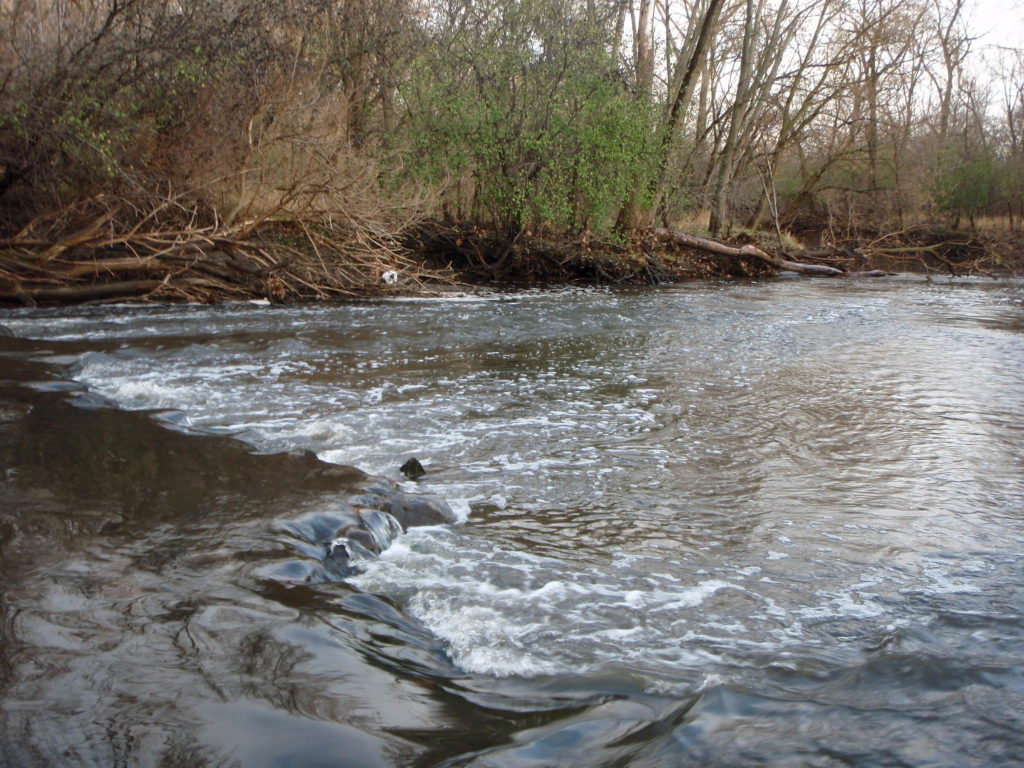
Spring Techniques
Most standard river walleye methods will produce during the early spring spawning run. With the primary objective being reproduction, eating is their least priority unfortunately. However, males will be most aggressive. Select lures that garner the attention of walleyes and invade their territory.
Think slow speed, but aggressive action to entice spring walleyes. When wading, you will be casting 100% of the time. But if a deep hole is located immediately near the shallow area you’re at, some variations of jigging and bottom bouncing will be acceptable.
During the spring runs, wade fishermen often over-complicate their approach to river fishing. For simplicity and effectiveness, limit your spring river wading tackle selection to three main categories: Jig and plastics/ thumper tails for slow and subtleness to maintain bottom contact; Deep diving crankbaits to probe deep holes; Medium size minnowbaits to power through mid-depth currents. Maintain the philosophy that these baits serve as functioning tools to get the job done.
Midsize Minnows – Lure profile, speed of retrieve, and lip vibration (good tuning) are more important properties of a good minnowbait than color and appearance. In spring, my minnowbaits are typically small and compact, 2 to 4 inches in length. Walleyes will often strike minnowbaits in mid retrieve as the lure is being cranked past the hole and through the current. Jerks and pauses can be used in mid retrieve, but the technique seldom works because feeding walleyes in rivers don’t tend to follow minnowbaits without a strike. When they cross paths, walleyes will slam them under a steady retrieve.

Targeting big walleyes in spring, my lure of choice for spring river walleyes has been a #8 and #10 Husky Jerk in an assortment of fluorescent and natural colors. Frequently fishing depths of 3 to 6 feet, they’re versatile and effective at powering through resting holes and ticking over shallow gravel bars with a slow to medium retrieve. They produce a more compact, tight powerful wobble during the retrieve. In my opinion, this triggering mechanism is the most important feature of the husky jerk. Both size Husky Jerks run about the same depth.

Suspending jerkbaits cast far and allow me to cover a lot of area and distance. I cast 3 inch Dynamic Lures Jspecs and moderately crank it with a straight retrieve through tail-outs, and along the deep edges of gravel bars that form pools. A steady retrieve will allow the Jspec to dive between anywhere from 2 to 4 feet depending on speed. With its wide wobble, loud internal rattle chamber, and suspending style when paused, the Jspec provokes strikes from lethargic and aggressive walleyes.
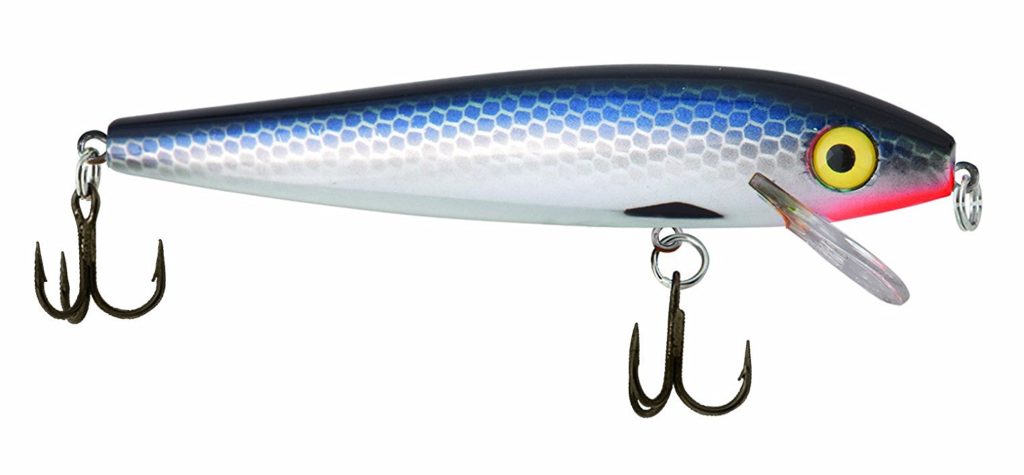
Conditions might be tougher on some days. In response, fish might want something a little different. Consider the properties of depth control with a Countdown Rapala, or the slender subtleness of an F9 or F11 Floating Rapala or 3.5 in. Rebel Minnow. Each of these baits will serve their time and purpose in spring.
Crankbaits and Divers – With holes being ideal resting spots for large females, crankbaits and deep divers allow casting anglers to probe through the depths. They’re an overlooked lure category for spring river fishing, but are perfect on N. Illinois rivers due to the abundance of shad forage.
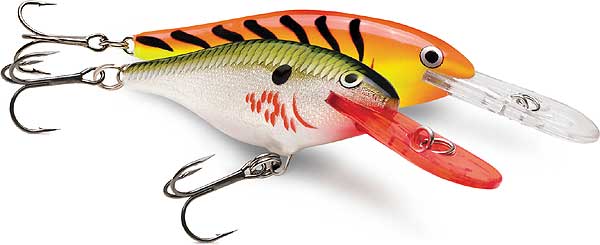
Most river anglers turn to Shad Raps for long line trolling by boat, but for river wading they are perfect for casting and cranking through deep pools. Speed isn’t as much of a factor as running depth. With a slow retrieve, I’m able to run size 06, 07, and 08 Shad Raps through most deep holes. Whether fished daytime or nighttime, if you’re not grazing any rocks or making at least some bottom contact with these baits, they aren’t being applied properly. Have some silver and shad colors, as well as the standard firetigers.
Jig and Thumper Plastics – The third lure category that is mandatory for spring wading is a ¼ ounce jig rigged with a large curlytail or thumper-tail shad style plastic. Jigs and plastics are my most reliable producers in spring. In many situations when walleyes display low aggression levels, jig and plastic combinations out-produce minnowbaits and crankbaits. They can be bounced along the bottom or steadily retrieved through current.
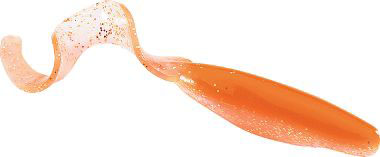
I fare best with plastics during the daytime hours. They work especially well in post-frontal conditions, and when the fish are tight-lipped either due to weather factors or if they grow conditioned to certain lures and angling pressure. Favorites are Lindy Tackle’s Munchie grubs rigged with ¼ oz. jigs, and 4 inch Walleye Assassins, a slender swimbait available in both curly tail and paddle tail models. Other plastics worth consideration are small bass style paddletails, Storm WildEye Swim Shads, and curly tail ring worms. I’ve often had my best success fishing with bright unnatural colors such as orange and chartreuse.
I prefer rigging my thumper plastics with cone-shaped darter style swimming heads. This head design allows my plastics to cut though current easier so they can be retrieved at any depth and maintain it. The head shape also minimizes snags when hopped and pounded along bottom.
Most river terrain is abusive and gnarly to gear. Wade anglers can expect to lose a few baits to shallow rocks, but fishing with proper equipment will minimize your spring season donations to the river bottom. Braided superline such as hi-vis yellow 10 and 15 lb. Cortland Masterbraid has become mandatory on my size 20 and 30 Quantum spinning reels fished on 6 and a half to 7 foot medium action Vexan Walleye spinning rods. Whether jigging or casting, it helps prevent break-offs to snags. But most importantly, the sensitivity and high-visibility of yellow line greatly improves my catch rates and helps detect bites from passive and aggressive walleyes. Besides rod and reel, all you need in order to make it happen is a set of waders, a landing net, head lamp, and a small box of baits encompassing my big-three.
Spawning fish are extremely vulnerable to harvest and exploitation. Please use restraint if intentions are to harvest some for a meal. Even though special spring regulations at many walleye fisheries tend to favor reduced limits and promote conservation, the best regulation to enforce is releasing all females. Lower in abundance to males, who fertilize the eggs of many females, female walleyes are the necessity to reproductive success. Once it’s removed from the fishery, the river loses a lot of its reproductive success and long-term sustainability.
Far from a revolutionary tale, but an effective and engaging approach few are doing, catching spring river walleyes doesn’t require anything more beyond an understanding of spawning location, timing, and behavior. Throughout their range, walleyes are fit for rivers, exemplifying Darwin’s genius relative to fisheries and reproductive success. Dominant species in a majority of rivers, spring offers anglers the best fishing opportunities of the year as walleyes are motivated to migrate.


